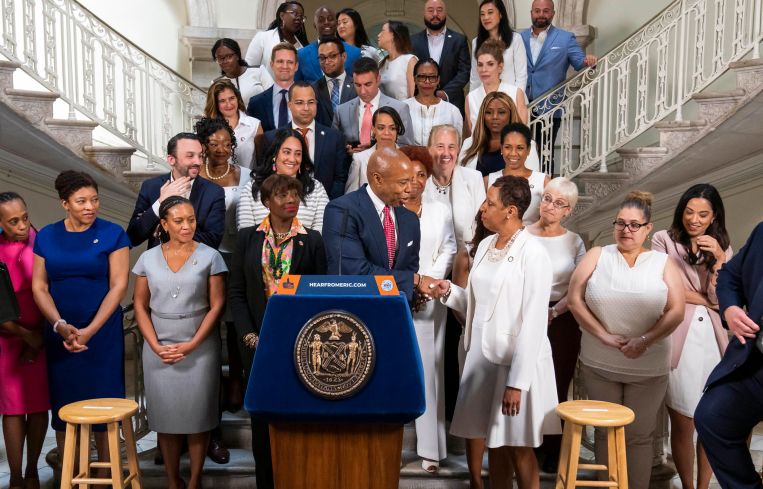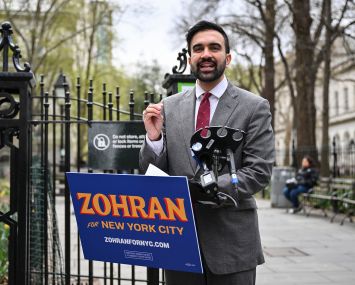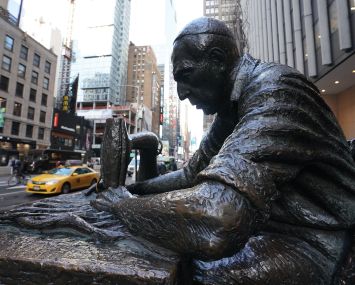NYC’s $107B Budget Deal Doesn’t Have Many Jumping for Joy
By Aaron Short July 6, 2023 12:04 pm
reprints
After months of strained negotiations, Mayor Eric Adams and New York City Council leaders reached a $107 billion budget deal last week, and neither party seems that happy about it.
One week after signing off on the 2024 fiscal year budget, Council Finance Committee Chair Justin Brannan acknowledged that council members had to recalibrate expectations to reach a compromise with the mayor, who wanted even steeper cuts for libraries and education.
“Money was tight, we had to negotiate the best possible outcomes because of multiple challenges facing our city right now,” Brannan told Commercial Observer. “When there’s not enough money to do everything you want to do, it’s always going to be tough.”
Last fall, Adams told most city agencies to trim their budgets to shrink a $3 billion deficit that could rise as pension costs grow while business and personal income taxes are predicted to dip in the coming years. His budget office repeated those calls to find savings in April.
Council leaders were able to restore some reductions. Adams initially threatened to slash $36 million from the city’s three public library systems over the next two years. A public outcry ensued when libraries said they would be forced to reduce weekend service, and the cut was reversed.
Other services remained on the chopping block, including several educational and re-entry programs for Rikers Island inmates that nonprofits provided. The city’s education budget will also shrink in response to declining enrollment, although individual school budgets may not vary much.
Still, some business leaders want city officials to think creatively to save more money in future years.
“Spending seems to be the solution to every problem,” Kathy Wylde, president and CEO of the Partnership for New York City, a nonprofit that represents private sector leaders, said. “The mayor is trying to contain costs but encounters resistance from council members and advocates. The projected budget deficit should force us all to think about spending more wisely.”
Crises averted
The city’s two biggest crises — a lack of affordable housing and a surge of asylum seekers — require additional assistance from the state legislature and Congress.
Mayor Adams and other city leaders have visited Washington, D.C., to plead for more federal funding to tackle the influx of migrants from Latin America. Adams said the city planned to spend $4.2 billion on housing, food and other services to help migrants in 2023 and $2.8 billion in 2024, although the Independent Budget Office estimated the costs for those services could come at $1.5 billion less than Adams administration officials projected.
“The costs associated with asylum seekers have significantly increased during 2023, with the continuing influx of asylum seekers and escalations in shelter costs as the city continues to ramp up capacity,” IBO director Louisa Chafee said in her budget testimony in May.
City leaders, meanwhile, set aside $4 billion for affordable housing in the budget, which Council Speaker Adrienne Adams asked for last year.
In addition, the council made a maneuver to make $150 million in additional capital spending available sooner, since the money was budgeted in later years.
Other housing programs also got an infusion of funds. The city’s rental assistance program, run by the Human Resources Administration, received a total of $262 million.
But the city remains wholly dependent on state lawmakers for larger tranches of housing funding, as well as changes to zoning laws that could ease the conversion of underutilized offices and tax incentives that could galvanize the construction of new homes.
Legislators left the state capital last month with a long to-do list and little accomplished.
“It’s wild that Albany went home without any affordable housing incentives,” Brannan said. “Developers are saying, ‘We’d love to do something affordable,’ but they can’t convert a giant office building because it’s too expensive to do it and they have to make it market rate.”
Spending up, headcount down
The city’s new budget is $6 billion higher than the previous year’s budget due to new contracts made with municipal unions.
But some agencies and initiatives also saw spending increases. The Department of Sanitation received $22 million to clean litter baskets more often. Public defenders got $36 million for their “Right to Counsel” program. And the City University of New York tallied $20 million to help its students complete college.
The New York City Police Department received an increase of about $320 million, despite being targeted by the council’s progressive caucus for cuts. NYPD overtime was not part of the negotiations even though Mayor Adams pledged to slice it in half. Instead, council leaders hope a new schedule that would put patrol officers on 12-hour shifts will reduce extra hours.
Other agencies weren’t as lucky. The city’s employee headcount, which is already down over 19,000 positions since the Great Recession, could continue to shrink, as some positions will be eliminated entirely.
Brannan wants key roles in housing agencies filled to help the city reach its housing goals.
“We had weeks of testimony from agencies and commissioners crying out for help that they don’t have the staff they need to do what needs to be done,” he said. “You need the folks behind the scenes who are processing paperwork, which are just as important as the construction jobs.”


